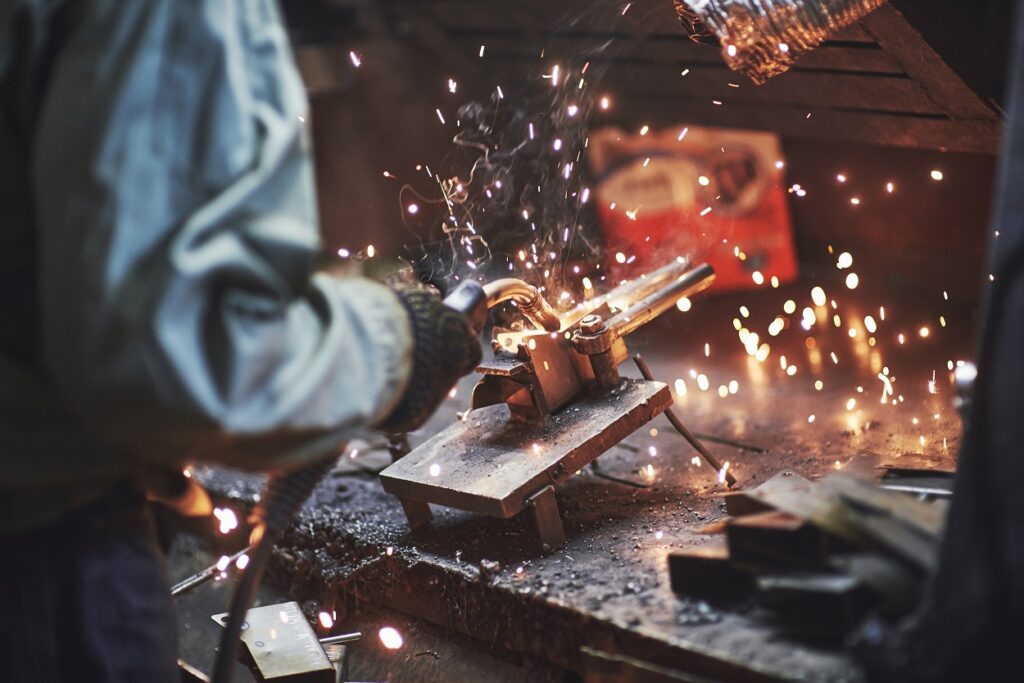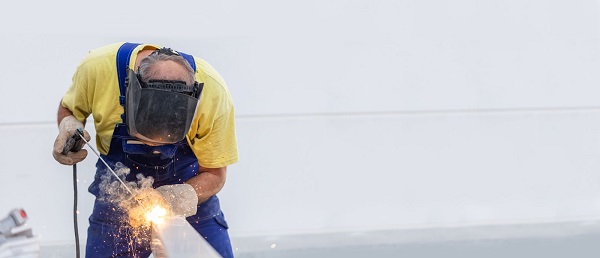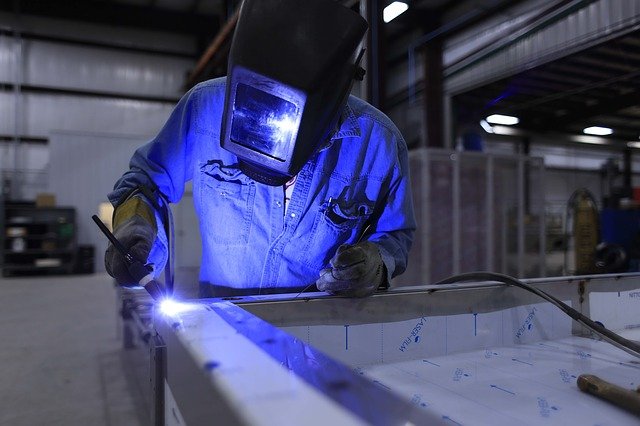With more than 80 different types of welding processes used across industries in the US and each carrying its own risks and potential hazards, it’s easy to see how sticking to all the OSHA welding requirements can be difficult for business owners.
But, putting in the time and effort to ensure OSHA compliance with safety precautions can save you a significant amount of money in the long run, should an inspector come around.
Here’s a brief guide on OSHA welding requirements.

What Are the Main Types of Occupational Safety To Be Observed With Welding?
Hazards created by welding, cutting and brazing operations can be split into three categories:
- Fumes and gases,
- Radiant energy, and
- Fire.
1. Fumes and Gases
Welding operations performed in confined or enclosed spaces can lead to suffocation because of gases being emitted, such as helium, argon, and carbon dioxide. Carbon monoxide can form as a byproduct, which can be a serious asphyxiation hazard.
Different factors can affect a worker’s exposure to welding fumes, such as:
- the type of welding process being used;
- which base and filler metals are being used;
- welding rod composition;
- whether welding operations are performed outside or in an enclosed space;
- welder training and work practices;
- air movement and circulation; and
- the use of ventilation controls.
To reduce workers’ exposure to dangerous welding fumes, OSHA welding safety requirements include training around:
- the materials being used and each of their unique hazards;
- how to clean welding surfaces and how regularly, to avoid any buildup of residue that can lead to toxic exposure;
- how to position themselves around welding operations to avoid inhalation, for example staying upwind when in open or outdoor environments; and
- knowing when, and how, to utilize exhaust ventilation systems, for example, in a very confined space.
2. Radiant Energy
Radiant energy or light radiation is emitted from an arc or flame and can injure a worker’s eyes, face, and other parts of their body.
Specific personal protective equipment (PPE) is required:
- safety glasses;
- goggles;
- welding helmets;
- welding face shields; and
- protective clothing.
The eye-protection equipment must include filter lenses with a specific shade number to indicate the intensity of light radiation that can safely pass through the lens. Eyewear with filter lenses being worn under a welding helmet provides enough protection that the shade number of the helmet may be reduced.
Take note that eye and facial protective shields should provide side protection too as fragments can fly in any direction.
3. Fire
There are numerous precautions that should be put into place for fire prevention according to OSHA standards:
- If the objects being cut or welded, or welding machines, are immovable, movable fire hazards and readily combustible materials around them must be moved instead. If that isn’t possible, for example, cracks or floor openings, or holes in the walls that can’t be covered, guards must be used to confine the heat, sparks and slag.
- Be sure to have fire extinguishing equipment readily waiting and operational close to the welding environment. This includes buckets of water or sand and a hose.
- Fire watchers should be utilized where a minor fire could develop, and be suitably trained in the appropriate fire extinguishing techniques, and how to sound the alarm.
Most of these should be established, implemented and enforced by the supervisor.

4. What Personal Protective Equipment Is Required?
As the employer, it’s your responsibility to ensure that workers have the correct PPE. Additionally, according to OSHA standards, they need to be trained on what its uses are, why it should be used, as well as when.
Take note that helpers or watchers also require appropriate protective clothing and proper eye protection.
PPE includes:
- eye protection;
- helmets;
- hand shields; and
- face shields.
For occupational safety, PPE should be:
- made from insulating material;
- able to withstand sterilization; and
- inflammable.
Who Requires Welding, Cutting and Brazing Training?
Because of the extensive amount of hazards created by welding, cutting and brazing operations, in-depth training is required to be compliant and meet OSHA standards.
This guide only touches the tip of the iceberg as the complexity of the OSHA regulations shouldn’t be underestimated.
Complete and appropriate training should be provided to each of these groups respectively:
- the employer;
- supervisors; and
- workers.
1. The Employer
- The employer requires adequate training on which PPE is appropriate for which situation and why, to establish which is appropriate for their workers in their workspace. They should then enforce that this is adhered to.
- The employer should be trained on toxic gases and conduct tests to determine whether ventilation is adequate.
- Although not essential, it’s highly beneficial for the employer to be trained on OSHA logs, as well as knowing when, and how, to document an OSHA recordable incident regarding occupational injury and illness.
2. Supervisors
- Any training provided to other staff members will be beneficial for supervisors as they are responsible for ensuring that everything runs smoothly, correctly, and safely.
3. Workers
- Certain welding, cutting and brazing processes require workers who are suitably trained to perform the specific type of operation, for example, oxy-acetylene, oxygen-powder, carbon arc, gas tungsten, resistance spot. Those workers should receive appropriate training.
- Each piece of equipment, including PPE, requires training for workers operating it as per the manufacturer’s instructions.
- Training on welding, cutting, and brazing safety hazards, and how to prevent or minimize these, including what and when to wear PPE.
- Workers must be trained to perform checks on equipment and PPE to ensure their workability.
- Training on fire hazards, flammable, and explosive situations must be provided, including immovable fire hazards, a fire prevention and response program, with fire extinguishers and fire watchers.
- Training for safe material handling and storage practices, particularly for gas cylinders is required.

How Can Insure Compliance Help?
At Insure Compliance, we apply our unique Safety Gap Model to help companies achieve compliance with OSHA standards, including welding requirements.
At Insure Compliance, we apply our unique Safety Gap Model to help companies achieve compliance with OSHA standards, including welding requirements.
- establishing why the safety gap exists;
- identifying the symptoms; and
- implementing a solution.
Then, we offer particular training courses to help you reach your OSHA welding safety requirements, such as:
Key Takeaways
There are three types of hazards associated with welding, cutting, and brazing operations, including fumes and gases, radiant energy, and fire.
By training the employer, the supervisors and the workers on the hazards involved in welding, how to maximize occupational safety, and what PPE to use when, you can reduce the risk of fines and penalties if you receive a visit from an OSHA inspector.
Begin your journey to compliance today by scheduling one of our Safety Audits, and we can identify where your Safety Gaps are and provide the appropriate training to bridge them.
Disclaimer:
Please note that every effort has been made to ensure that the information provided in this guide is accurate. You should note, however, that the information is intended as a guide only, providing an overview of general information available to businesses. This guide is not intended to be an exhaustive source of information and should not be seen to constitute legal, safety or business advice. You should, where necessary, seek your own advice for any issues raised in your affairs.







